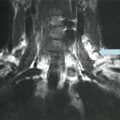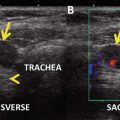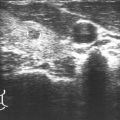© Springer International Publishing Switzerland 2016
David S. Cooper and Cosimo Durante (eds.)Thyroid Cancer10.1007/978-3-319-22401-5_3838. Management of Postoperative Hypercalcitoninemia in MTC
(1)
Clinique de Chirurgie Digestive et Endocrinienne (CCDE), Institut des Maladies de l’Appareil Digestif (IMAD), Hôtel Dieu, CHU Nantes, Place Ricordeau, 44093 Nantes cedex 1, France
Keywords
Medullary thyroid carcinomaCalcitoninCEADoubling timeCase Presentation
A 62-year-old man, without any significant medical history, presented to a gastroenterologist with chronic diarrhea of 1-year duration. He did not take any medications except for occasional anti-inflammatory drugs. In general, he felt well. The diarrhea was sometimes associated with hematochezia. The patient’s physical examination was normal. The endoscopic work-up (upper endoscopy and colonoscopy) and abdominal ultrasound (US) were normal. Laboratory testing revealed a serum calcitonin (Ct) level of 1000 pg/mL and CEA level was 86.7 ng/mL. Thyroid and neck US showed a posterior right 13 × 10 × 10 mm hypoechoic, irregular thyroid nodule. Furthermore, a right jugular (8 × 3 mm) and a left subclavicular lymph node (47 × 19 mm) were identified. Chest and abdominal computed tomography (CT) scans showed another left jugular lymph node (23 × 20 mm), small mediastinal lymph nodes, and two left adrenal nodules (12 and 18 mm). These findings were highly suggestive of the diagnosis of medullary thyroid carcinoma (MTC). Biologic measurements excluded associated pheochromocytoma and primary hyperparathyroidism (PHPT).
Total thyroidectomy with bilateral central and jugular lymph node dissection was performed. Histological examination confirmed the diagnosis of MTC on the right (primary tumor: 2 cm in diameter), with mild C-cell hyperplasia in the left thyroid lobe and major lymph node invasion (36 out of 52 bilateral lymph nodes were involved: 15 involved nodes out 21 in the central compartment, 17/23 in ipsilateral lateral compartments, and 4/8 in the contralateral lateral compartment). The primary tumor had minimal extrathyroid extension (pT3) and the resection margins were positive (R1). Tumor was finally classified pT3 N1b Mx R1. The postoperative serum Ct level was 71 pg/mL.
Assessment and Literature Review
MTC accounts for 5–10 % of thyroid cancers. It is histologically defined as a tumor arising from the calcitonin-secreting parafollicular C cells of the thyroid gland. MTC is known as an indolent disease despite early lymph node and distant metastatic spread. Cervical lymph node metastases are identified in 25–82 % of MTC cases [1–3]. Distant metastases at presentation are found in 7–23 % of patients [4–8]. The main distant metastatic sites are the bone, liver, and lung [9]. In general, when MTC has spread out of the neck, there are no established therapies that can offer the possibility of a cure, and the 10-year survival rate drops below 40 % [10].
Postoperative Staging of MTC Patients
Postoperative biologic monitoring mainly relies on serum Ct, a sensitive and specific indicator of residual tumor. For practical purposes, persistently elevated serum Ct levels mean that disease still exists [4]. A serum Ct level >150 pg/mL should lead to an extensive work-up to detect and localize residual disease [4]. Giraudet et al. [11] proposed a standard optimal imaging work-up to detect MTC metastases, consisting of neck US, chest CT, liver magnetic resonance imaging (MRI), bone scintigraphy, and axial skeletal MRI. Using that protocol, the authors were able to detect 98 % of neck recurrences, 100 % of mediastinal lymph nodes, lung and liver metastases, and 94 % of bone metastases.
Bone involvement in advanced medullary thyroid cancer is frequent; in one French series, 74 % of patients developed skeletal metastases. Bone MRI and post-radioimmunotherapy (RIT) immunoscintigraphy appeared to have a higher sensitivity to detect bone involvement compared with bone scintigraphy, with a 100 %, 100 %, and 72.7 % sensitivity, respectively, in a population treated by RIT [12].
Prognosis of Postoperative Patients
The TNM classification is presented in the box. Global 10-year disease survival of MTC is about 75 % [13]. Specific 10-year survival rate decreases from 100 % to 93 %, 71 %, and 21 %, respectively, for stage I, II, III, and IV [14]. For patients with distant metastasis at diagnosis, the 10-year survival rate is 40 % [10].
Box: TNM Classification (American Joint Committee on Cancer)
Primary tumor (T)
T0—No evidence of primary tumor
T1—Tumor 2 cm or less in greatest dimension limited to the thyroid (T1a: tumor 1 cm or less; T1b: tumor more than 1 cm but not more than 2 cm)
T2—Tumor more than 2 cm, but not more than 4 cm, in greatest dimension limited to the thyroid.
T3—Tumor more than 4 cm in greatest dimension limited to the thyroid or any tumor with minimal extrathyroidal extension (e.g., extension to sternothyroid muscle or perithyroid soft tissues)
T4a—Tumor of any size extending beyond the thyroid capsule to invade subcutaneous soft tissues, larynx, trachea, esophagus, or recurrent laryngeal nerve
T4b—Tumor invades prevertebral fascia or encases carotid artery or mediastinal vessels
Regional lymph nodes (N)*
NX—Regional lymph nodes cannot be assessed
N0—No regional lymph node metastases
N1—Regional lymph node metastases
N1a—Metastasis to level VI (pretracheal, paratracheal, and prelaryngeal/delphian lymph nodes)
N1b—Metastasis to unilateral, bilateral, or contralateral cervical or superior mediastinal lymph nodes
*Central compartment, lateral cervical and upper mediastinal lymph nodes
Distant metastases (M)
MX—Distant metastasis cannot be assessed
M0—No distant metastasis
M1—Distant metastasis
Stage
Stage I: T1, N0, M0
Stage II: T2, N0, M0
Stay updated, free articles. Join our Telegram channel

Full access? Get Clinical Tree






